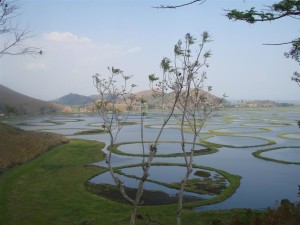In the northeast area on India, Manipur, Loktak Lake is considered to be the greatest freshwater lake and is also known as the floating lake due to the floating phumdis on it. The term phumdis signifies the heterogeneous heap of vegetation, organic matters and soil which is on the verge of decomposition. The Keibul Lamjao National Park is one of the natural habitats for the refuge of the endangered species. It consists of Sangai or Manipur browantlered deer and other endangered animals. They covered an area of 40 sq km and are located in the southernmost shores of this water body. It contained the largest amount of phumdis.
This lake helps the ecosystem of the Manipur region and also serves as the main reserves of water for the generation of hydroelectricity, drinking and irrigational purposes. It also provides fishing opportunities to the local people who live in the areas adjoining to the phumdis. It helps local people to earn their livelihood. The lake is also considered as a wetland and this area has a population of 1 lac people. The Ramsar convention designated the lake on 16th June 1993. Due to unhealthy human activities, the ecosystem of the lake gets affected by many ways.Next Post
Bakkhali tourist spot
Sat Jan 7 , 2017
Share on Facebook Tweet it Share on Reddit Pin it Email Bakkhali is certainly a great place which is located in West Bengal, and is located at a distance of about 134 km from Kolkata. This is considered to be the perfect place for relaxing, especially during the summers. Apart […]

You May Like
- Sep 18, 2018
How to Make Your Safari tour Most Memorable One
- Jul 1, 2017
Camping in Rishikesh
- Sep 11, 2020
8 Thrilling Cycling Routes In India

